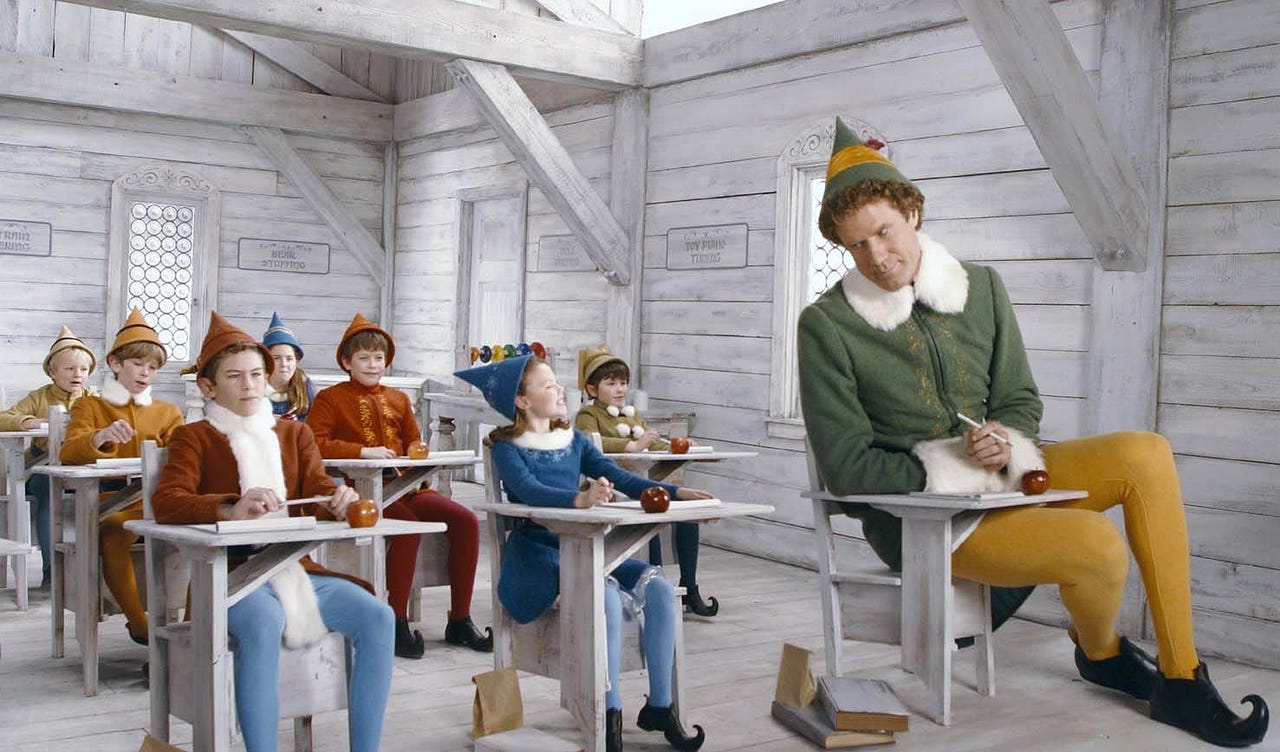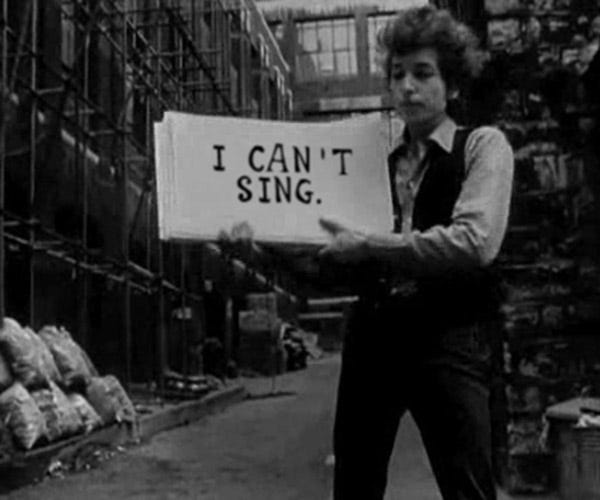Augmented and Virtual Reality in Education — Part 3: Remote Schooling
Augmented and Virtual Reality in Education — Part 3: Remote Schooling
- Last Updated: December 2, 2024
Scottie Gardonio
- Last Updated: December 2, 2024



Times are changing. We once saw small country schoolhouses teach a handful of children at varying ages within the same classroom. Since then, schools have increased in size and classrooms are filled to the brim. Still, we see little progress in how students are taught, as the preferred method tends toward perfectly-lined desks filled with eager minds struggling for comfort on curiously uncomfortable seats, undoubtedly designed to discourage sleep.

Image Credit: Elf (New Line Cinema)
In part one of his educational series, Augmented and Virtual Reality in Education: K-12, we looked at how new technology in AR/VR has and will provide different and arguably better educational experiences for students.
Part 2 of the series, Augmented and Virtual Reality in Education — Part 2: Higher Ed, explored how AR/VR is revolutionizing how instructors can efficiently teach in safer, non-textbook, hands-on ways, giving future professionals the tools to better succeed.
While both Part 1 and Part 2 outline how we can better serve the worlds’ students now and in the near future, what if it were taken even a step further? What if we could evolve the entire educational system to give future generations an entirely reimagined schooling platform from which instructors and students, alike, are empowered with the tools for all to succeed, regardless of often significant barriers?
A Brief Pause
Before we move on to reimagine future schooling, it is important to take a moment to acknowledge our current educational professionals. While thinking about how the industry may move forward, as industries of every kind do, we must not diminish the dedication and passion we all depend upon from those currently doing great work by serving our youth. They invest their time and emotion into their students, pay for supplies out of their own pockets, and spend countless late-night hours working long after school bells have rung.
Instead, this article aims to find educational paths where both students, instructors, and additional personnel feel more empowered and reap the benefits from what augmented and virtual reality can provide to future school models.

Image Credit: XQ Super School Live
The Movement is Already Underway
Recently, an educational-based special, XQ Super Schools Live, aired on TV. Taking over every major network for a full hour with minimal prior marketing or announcements, this airing was tantamount to a broadcast flashmob.
If you don’t have Netflix, cable, a DVD player, a VCR, any video games, a computer, a radio, access to podcasts, or a smartphone with endless social media feeds, and you also found yourself plan-less on this particular Friday night, you probably sat down and watched this insanely important hour-long special.
Celebrities, students, teachers, and networks banded together to start the discussion on how high schools can change their teaching models to better prepare their students for life today.
Their main argument was that teaching models have not evolved at the same rate as many other things in our society.
Their own opening argument compared the strides made in the automobile and phone industries to provide visuals articulating the issues.
Cars have evolved. Phones have, as well.
Classrooms and teaching methods remain rather similar to what was done in the early 1900s.
As XQ Live described, classrooms were once intended to help prepare students for future lives in what was an increasingly industrial world. Now, however, we have not changed enough to adequately prepare students for their future lives and careers in technology-based economies.
According to those at XQ Super Schools, they challenged a handful of high schools to reimagine entire school models.
Some schools opted to work with the students in more active/hands-on manners — in one case putting teens to work in gardens, learning from action versus a book.
In other cases, classes were created to better teach creating today’s technology, such as virtual reality.
These schools saw increased engagement from students, better grades, and drastically increased graduation rates, even in impoverished communities.
In previous augmented and virtual reality articles, I have described how these technologies will change everything from retail and customer service to tourism and social media. In Parts 1 and 2 of this series, we looked at how it can change the existing school models for the better.
But, what if we combined the wants and needs of existing students, the newer models seen in XQ Super Schools, and AR/VR to give every student the utmost chance to succeed in their education?
Changing Home Schooling
Perhaps a family can’t afford to purchase a house in the district with the best schools, so their children attend sub-par facilities, putting them behind others before high school graduation even happens.
In some cases, this will lead families to make the tough decision to home school their children. Even then, only those families financially stable enough to sacrifice a second income for the benefit of their children’s education are able to go this route.
What if it didn’t have to be that way, though? What if the barriers blocking one child from getting the exact same education as another due to location came down?
One child from the south, we’ll call him Mark, could attend school with another child from the north, Adrianna. Mark’s school, unfortunately, does not have AP Calculus, but Adrianna’s does. So, instead of Mark going to pre-calc with his daily classmates, he ventures to a separate room in the school equipped with VR headsets.
Upon entering the room, Mark adorns his head with the headset, logs in to his virtual class, and along with students from anywhere, learns AP Calculus in a class of equally-eager math enthusiasts.
Adrianna, equally gifted at math, finds her passion in engineering. However, despite her school having a better educational reputation than the previous mentioned school, they do not provide pre-college courses. For that, Adrianna must enroll in post-secondary, but she has no car for transport.
Instead of Adrianna being educationally stifled by her lack of transport or ability to teleport (Scotty isn’t “beaming” anyone anywhere right now), she follows up AP Calculus with a trip to her school’s own virtual reality room. There, as she activates an available VR program, she participates, in real time, a professor’s engineering activity as the whole college class virtually explores the results of the most recent class project.
Home Schooling for Other Reasons
Families don’t always choose home schooling based on the availability of good schools in their area, though. Sometimes it’s so parents feel more in control of the curriculum, and other times it can be to avoid or eliminate harsh bullying.
In all of these situations, however, home schooling poses a challenge to one of the core school rights-of-passage, which is learning how to interact with a variety of people and personalities.
While home schooling is not nearly as isolated as it has been in the past, there is still room for the improvement virtual and augmented reality can offer.
Let’s take Donna, who’s been home schooled with AR/VR since her early years. The curriculum her parents follow was developed through programs such as XQ Super Schools, where the education, while not ignoring the basics such as history and math, focuses on project-based learning.
Early on, Donna found a passion for agriculture and nature. Her desire is to own a small farm someday, and through AR/VR technology, Donna’s parents were able to formulate curriculum angled toward best preparing their daughter for her future career in college and life.
Via her AR wearable or device, Donna is able to work on projects such as identifying plants and possible diseases or pests. Since everything she sees is uploaded in real time, she and her classmates, some residing in cities hundreds of miles away, have made this particular project into a timed scavenger hunt where the first to correctly identify twenty-five plants wins.
In her next class, Donna enters a virtual chemistry lab. Her, along with an instructor and fellow students who differ from those she currently beat during the scavenger hunt, experiment with chemicals and reactions in ways she may not have done in the kitchen of her childhood home.
Donna’s parents, along with the session instructors and program creators, have now provided Donna with educational experiences that fit her emotional and goal-based needs. And, while she does not attend a school facility on a daily basis, she does not lack for friends and finds camaraderie among students who have like-minded interests.
Online Schooling
So, you’ve graduated high school. Now, it’s off to university, as we’re told. But, can you?
Colleges and universities around the world are filled with students eager to move into the next stages of their lives after they’ve completed their career-based training. Many live the “standard” college life. They move into a dorm, take out student loans, meet new friends, attend class in their comfiest of clothes and enjoy some weekend parties.
Of those, many will take on roles within their universities as part of school groups or organizations. Others might opt to take on part time jobs in order to mitigate future debt. Some are lucky to have, or have worked hard for, a full ride to a good school.
This is not the case for all students, though. There are many reasons that now make a non-traditional college path a reality for more and more students every year.
A variety of reasons can force any student toward the non-college trajectory.
- Lack of funding: for whatever reason, such as the family doesn’t qualify for student loans, many students cannot afford higher education.
- Distance: if you don’t live in the same town as a school you’ve been accepted to, housing challenges could prevent you from attending school.
- Distance, again: perhaps the school you’ve been accepted to is too far away from a family for which you are a caretaker (such as an ailing parent or your spouse and children — none of which can move to the college town with you).
- Time: you’ve started college a handful of years later than most, and now you have a full-time job. Breaking away to venture to and from a campus for classes two to three times a day is not feasible.
- Availability: similar to “time,” you’ve decided you can only attend class at night, but the classes you need are only offered during the day.
For these reasons, and many more, students are demanding online courses at an increased rate. There are even a handful of fully-online universities. However, there is still a bit of a stigma attached to online coursework, as many believe this type of schooling cannot be as rigorous as in-class learning.
Certainly, we can see why.
If my newly-minted doctor were to sit me down in his office and I saw an online degree on his wall, I would seriously contemplate his validity. How much hands-on work did he have? Has he seen a human’s heart outside of a textbook drawing or technical video? If he’s my doctor, his education is important to me.
In the art fields, where creation and critique go hand-in-hand, how can one get a well-rounded education when simply uploading a project to a server?
In point of fact, if I were to go to an online school for vocal music, I can guarantee I’d give myself high marks. However, I doubt anyone, even my bathroom mirror, would agree.

Image Credit: Sing Out!
So, while online schools look to fulfill the needs and overcome the challenges many students encounter, they can lack the well-rounded nature of what in-class learning provides.
Online Schooling Becomes AR/VR University
Thankfully, we are entering a time when online schooling can merge with emerging technology to become something entirely new.
Arnold, an up-and-coming star in marketing and advertising, previously went to college via the traditional route. He graduated on time, and found a good entry-level career early on. After years of hard work, everyone is noticing his potential. He’s even been told he’ll be up for a promotion in the coming years, but there’s one caveat: to qualify for the next job, he’ll need additional schooling.
The job Arnold wants in order to move up the career ladder requires a marketing-specific degree. His business degree has served him well, but he now knows he’ll have to buckle down again in order to be a potential promotion candidate.
Arnold sees a few problems, though. While his employer is gracious enough to offer some tuition assistance, and they eagerly encourage additional education, they cannot solve all of the issues associated with attending college while working full time.
From his place of employment, Arnold calculates a forty-minute drive, both ways, from campus during the busy day-time traffic. In order to get this additional degree in a reasonable amount of time, he’ll have to take around fifteen credits per semester.
Depending on when classes are held, he’ll be commuting between campus and work around ten times per week. Even if he’s lucky and his classes are back-to-back, this schedule would successfully eliminate half of his work day.
Arnold’s employer provides encouragement, but they cannot sacrifice his time in the office to that level. So, after speaking with an admissions officer, he discovers his best path is to take one or two classes per semester, which will double the years he spends in class.
Thankfully, as we move into a time when AR/VR merge with online schooling for accredited degrees, we’ll see many of these problems are either mitigated or eliminated.
In a soon-to-be world, Arnold finds he’s able to sign up for full-time school in short order, and he’s well on his way to being qualified for the coveted promotion.
The time he would have spent in a car to commute to and from campus, is no longer an issue. Instead of wasting precious time in traffic, Arnold need simply activate a virtual or augmented reality device (whichever is deemed necessary by the class). His commute is now cut down to the time it takes to durn on a device and connect it to wi-fi.
Even better, he and his employer do not have to worry about where Arnold’s working hours are allocated, as Arnold can attend most of his classes in the mornings or evenings. Since a great deal of his coursework is based upon some lectures and an awful lot of reading, he does not have to present for a live event. This enables him to learn at a time of his choosing, when his mind can be fully-engaged.
However, many classes will require group projects or discussions. Thankfully, since his classes fully utilize the technology at hand, they have preplanned all of the lessons in ways that work for the majority of their students. A class discussion is planned for a topic on a specific day at a specific time. Arnold only needs to enter the virtual reality class hub to participate.
And, while the time scheduled is during his normal work day, the time requirement takes him away from work in a much more minimal way than the other schooling path would have, so his employer approves and allows Arnold to make up the couple of hours elsewhere.

We Have the Power
The technology is here, and the desire for alternative schooling methods is, as well.
By providing students with a different style of learning more conducive to today’s real-world needs, we give the younger generations a leg up on operating within these ever-changing times.
When we remove the barriers which separate some students from receiving the same education as others, we further provide opportunity to growing minds while they are still a captive audience.
And, when we can provide even the older or non-traditional learners the availability of further education, we are more likely to see an even more informed community than we see today.
All of these possibilities are enhanced or made possible by the technology gifts we call augmented and virtual reality. While many of us will not reap the benefits of this directly, as we cannot attend primary school as we did as youths (unless someone out there has a time machine — in which case, send me a direct message), we will see the results by way of our up-and-coming leaders and innovators.
The Most Comprehensive IoT Newsletter for Enterprises
Showcasing the highest-quality content, resources, news, and insights from the world of the Internet of Things. Subscribe to remain informed and up-to-date.
New Podcast Episode

Moving Past the Pilot Phase in IoT and AI
Related Articles
Are We Running Out of Infrastructure Capacity? What IoT Leaders Need to Know
December 18, 2025

Clarity Wins: What the Blue Jays’ World Series Run Teaches Tech Leaders About Alignment and Execution
October 24, 2025

The 7 Worst Examples of IoT Hacking and Vulnerabilities in Recorded History
October 3, 2025
